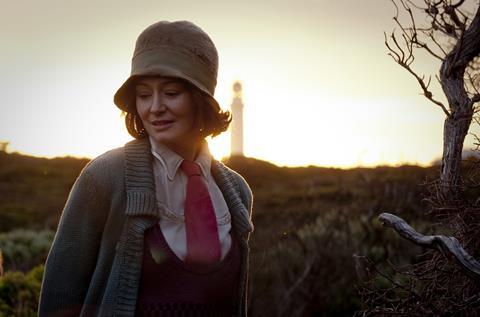Dir-scr: Shirley Barrett. Australia. 2010. 120mins

Shirley Barrett’s new movie, which opened the Sydney Film Festival before a packed 2000 plus audience, is a touching study of loneliness set on a meticulously recreated 1920s lighthouse island off the fiercely stormy southern Australian coast. Period details have been lovingly assembled — costumes, set dressings, dialogue, manners and the day-to-day routines and technicalities of lighthouse keeping in a bleak and hostile environment.
South Solitary rewards as much with its humane psychological insight as with its lighthouse reportage.
This admirable precision, plus some spectacular location filming, will guarantee international festival attention in the coming months, but the slow-moving story of damaged souls desperately seeking companionship will prove a tougher sell at the local box office (it opens July 29).
This is only Barrett’s third self-penned feature in 14 years. Her brilliant debut, Love’s Serenade, also starring Miranda Otto, won the Palme d’Or at Cannes in 1996, and her darkly witty Walk The Talk played festivals in 2000. She works patiently, prepares thoroughly and is an excellent director of actors. South Solitary rewards as much with its humane psychological insight as with its lighthouse reportage.
Meredith Appleton (Otto) arrives by launch at South Solitary, a desolate lump of rock topped by an elegant, white, pencil-slim lighthouse that her intolerant, homourless uncle George (Barry Otto) is to manage following the suicide of the previous keeper. She brings a live, serene, lamb for company and reminds herself “I must try to remain cheerful”. It’s a difficult resolution, for the ascent by a rickety haulage system to the top of the rock is dangerous, and, once there, the accommodation is bleakly primitive. The stiff-backed uncle and the niece with an unhappy past must make the best of things.
Already on the island is assistant keeper and inveterate womaniser Harry Stanley (Rohan Nichol), with his wary wife Alma (Essie Davis) and their three feral children. The inexperienced Meredith is grist to their bored will. Harry twinkles an eye, Alma sees trouble and remains aloof, 10-year old Nettie (Annie Martin) first takes over the lamb, then abandons it to the island. Also employed is the brooding, silent Jack Fleet (Marton Csokas), a Welshman damaged by the Great War and now as far from Europe as possible.
The daily routine on this few hundred square yards of looming rock pounded by crashing waves and frightening gales is marvellously created by Barrett and her actors. Miranda Otto, in virtually every scene, gives a fully rounded portrait of a naïve, lonely, needy woman unsure of her worth. Barry Otto (the actress’s father) is exceptional as the unbending martinet, loyal to the lighthouse keeper’s duties and code of honour.
After the cast is whittled down to two at the halfway point a painfully slow, shy courtship develops — psychologically accurate, perhaps, but overlong and hard-going for any multiplex audience expecting faster complications and racier payoffs. Older female audiences, currently so under-served, may be more tolerant.
Production values are first class. There’s a powerful sense of a distant time and a very distant place. A long search for suitable locations meant that filming was done at two separate lighthouses — one for the spectacular exteriors, and another for the authentically cramped and beautifully preserved interiors.
Production companies: Macgowan Films, Screen Australia, Film Victoria, Screen NSW, Omnilab Media
Australia/New Zealand distribution: Icon Film Distribution
International sales: E1 Entertainment, www.e1entertainment.com
Producer: Marian Macgowan
Cinematography: Anna Howard
Production Designer: Paul Heath
Editor: Denise Haratzis
Music: Mary Finsterer
Main cast: Miranda Otto, Marton Csokas, Essie Davis, Rohan Nichol, Barry Otto, Annie Martin






![The Brightest SunScreen[Courtesy HKIFF]](https://d1nslcd7m2225b.cloudfront.net/Pictures/274x183/3/5/0/1448350_thebrightestsunscreencourtesyhkiff_312678.jpg)














